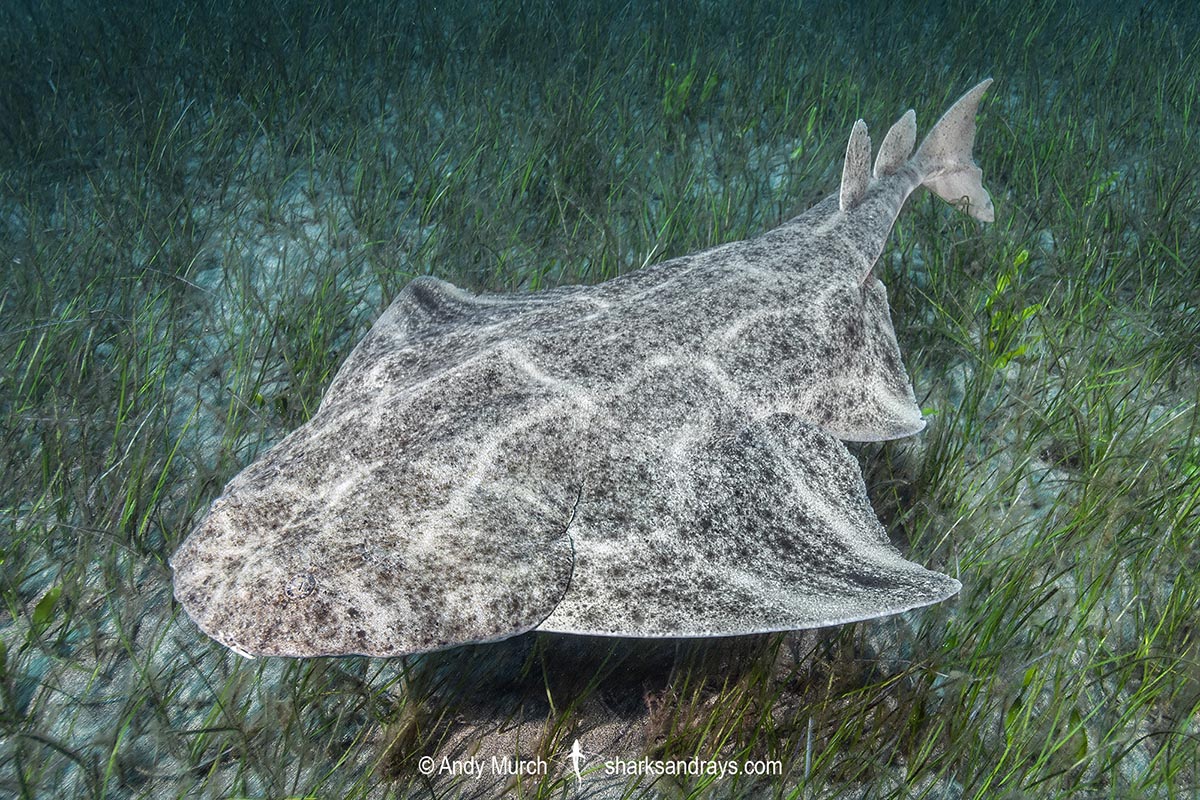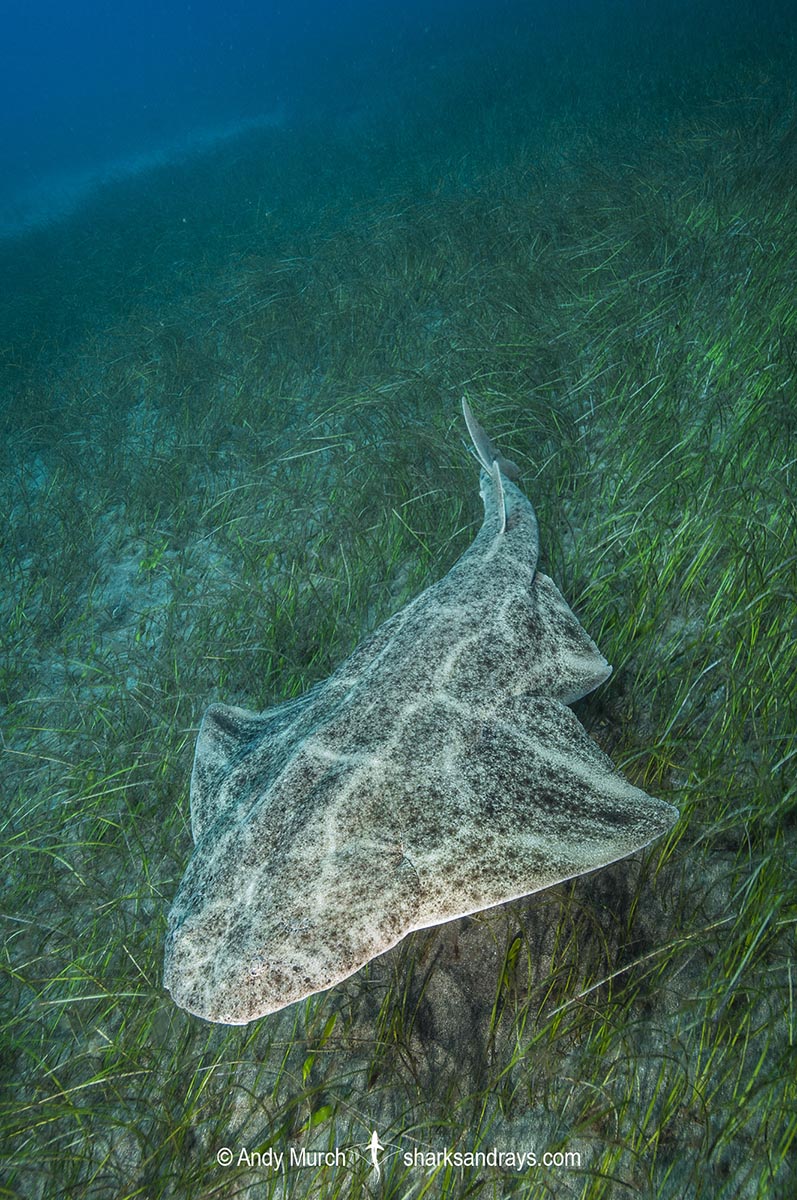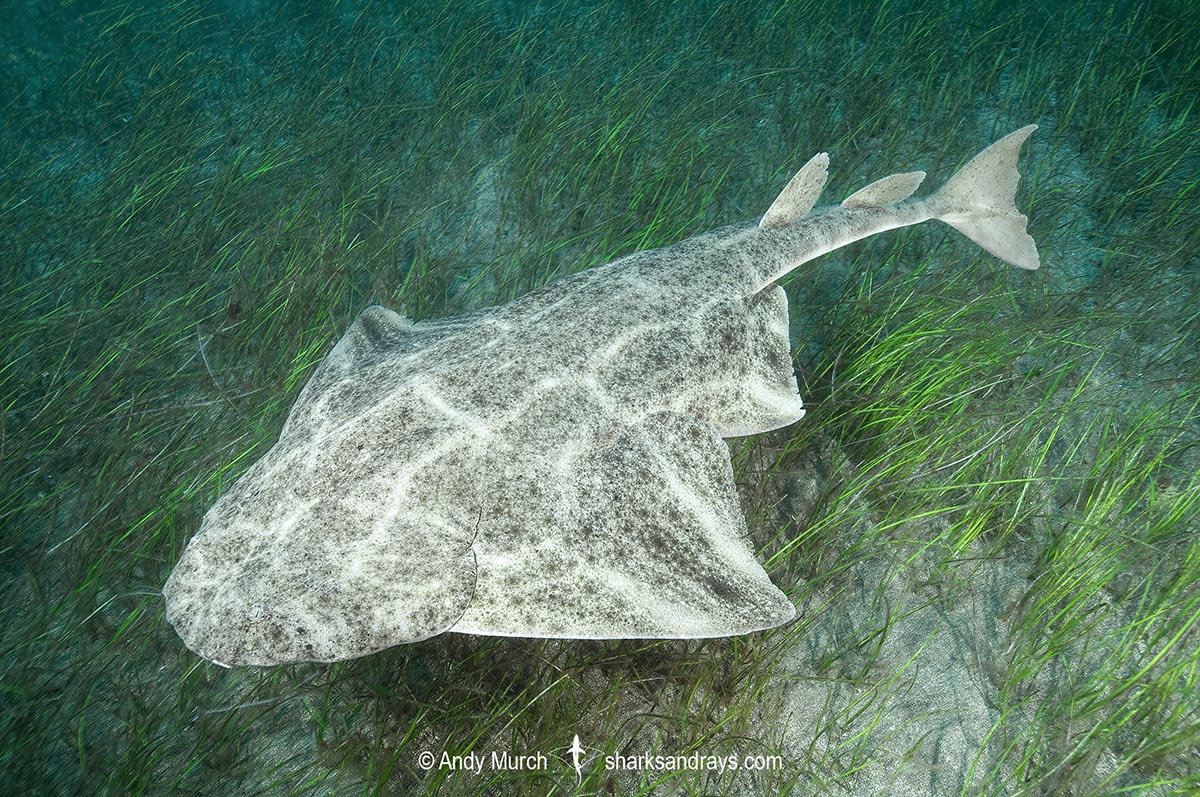Common name(s)
Angelshark, Monkfish, Common Angelshark.
Binomial
Squatina squatina
Synonyms
Rhina squatina, Squalraia acephala, Squalraia cervicata, Squalus squatina, Squatina angelus, Squatina angelus, Squatina europaea, Squatina laevis, Squatina lewis, Squatina squatini, Squatina vulgaris.
Identification
A large angelshark species with a relatively wide, short head that is inline with the pectoral fin margins. Barbells have unfringed, slightly spatulate tips. Anterior nasal flaps weakly fringed. One triangular dermal lobe present on each side of lateral head fold. Spiracle to eye width less than 1.5 eye size. Concave forehead between eyes. Thorns (enlarged denticles) present on snout and between eyes. Median dorsal row of thorns on back disappears in adulthood. Pectoral fins large with pointed apexes and concave posterior margins.
Dorsal coloration cream or tan or with a dense covering of very small dark spots that combine to form dark rectangles and polygons reminiscent of the volcanic and silica sand ripples where this species lives. Vague ocelli on pectoral fins. Ventrum pale.
Size
Maximum size 244cm TL (females) and 183cm TL (males) (Compagno 1984, 2005). Size at birth 24-30cm.

Conservation Status
CRITICALLY ENDANGERED
Common Angelsharks are a bycatch component of commercial trawls, set nets, dredges, and bottom longlines, which operate through most of their range. Although they are occasionally encountered in a few isolated pockets along the coast of Wales, the west coast of Ireland, the Tyrrhenian Sea, North Adriatic Sea, Aegean Sea, and Mediterranean coasts of Turkey, Algeria, and Egypt, the only area where they are found regularly is at the Canary Islands. In the North Sea between the east coast of the UK and the west coast of Skandinavia, the common angelshark is now listed as locally extinct.

Habitat
Tropical and temperate sandy and muddy substrates often close to monumentation such as rocky reefs where food is available. From estuaries (occasionally), shallow bays and the continental shelf. From the intertidal zone to at least 150m.
Distribution
Northeast Atlantic and Mediterranean Sea. Found from Scotland to at least the Canary Islands and possibly further south along the west African coast. The historical range of the common angelshark extended to central Norway but it is now considered regionally extinct north and east of the British Isles. Distribution in the Mediterranean appears to be patchy.
Reproduction
Like other squatinids, the common angelshark is an aplacental viviparous species. 7-25 pups per litter. Gestation period approximately 8-10 months. Give birth from December to February in the Mediterranean and in July in the UK.
Diet
Feeds on small demersal fishes including flatfishes and skates, as well as crustaceans and mollusks. There is one record of a common angelshark swallowing a cormorant.
Behavior
Migratory; moving offshore or north during the summer. Angelsharks tagged off of the west coast of Ireland were re-caught in Northern Ireland, southern England, France, and Spain.
Reaction to divers
Easy to approach. Remains motionless, relying on camouflage. Will bolt if molested. There is a record of a disturbed angelshark circling a diver with its mouth open in a threat display.
Diving logistics
The common angelshark is anything but common. Due to intensive fisheries and bicatch, the only reliable place left to encounter angelsharks is at the Canary Islands; especially near Arinaga on the south side of Gran Canaria.
I also encountered an angelshark at the stingray feed at Los Gigantes on the southwest coast of Tenerife.
Once in the right location, the best way to search for angelsharks is to swim along the edge of the reef, about 2m above the sand, in rocky or kelpy areas where the sharks have sand they can hide under and access to a good supply of fishes.
Although the shark will likely be buried under a fine covering of sand, their outline is often somewhat visible. Even if the outline of the angelshark is obscured, they always keep their eyes and spiracles exposed. After a few encounters, you should be able to pick out the signs of a shark’s presence more easily.
Once you have located a shark, with slow, non-aggressive movements, it is usually possible to settle down next to it and gently fan away most of the sand to get a better look. This does not distress the animal or significantly waste its energy because one or two pectoral fin flaps will completely cover it again. Be careful not to wave your hand too close to its mouth to avoid a demonstration of its incredibly fast bite reflex!
What’s new
View our full list of updates
Similar species
Sawback Angelshark Distinguished by its distinctive row of thorns running along the centre line of its back. A southern sympatric species usually found in water deeper than 30m.
Smoothback Angelshark Distinguished by spotted appearance. Mediterranean to southern Africa. Rarely found above 50m.










